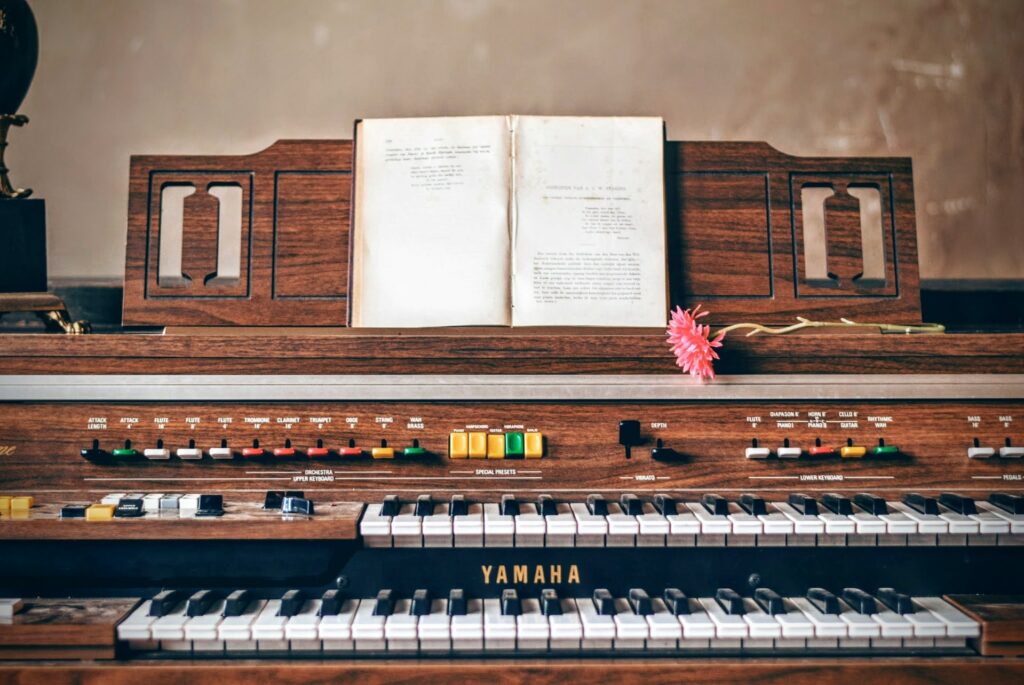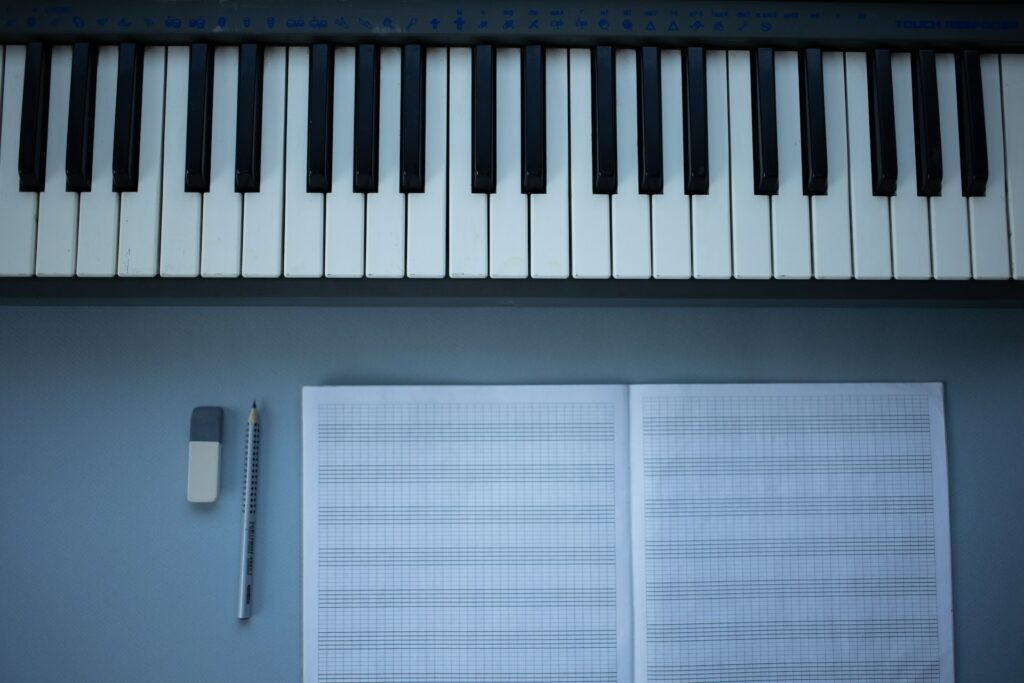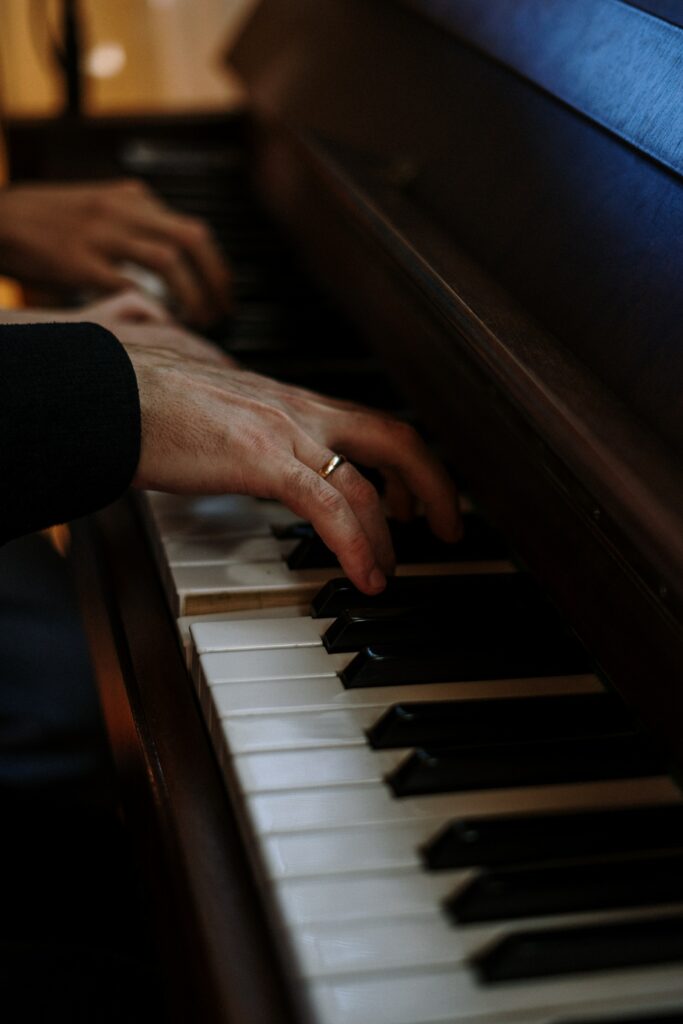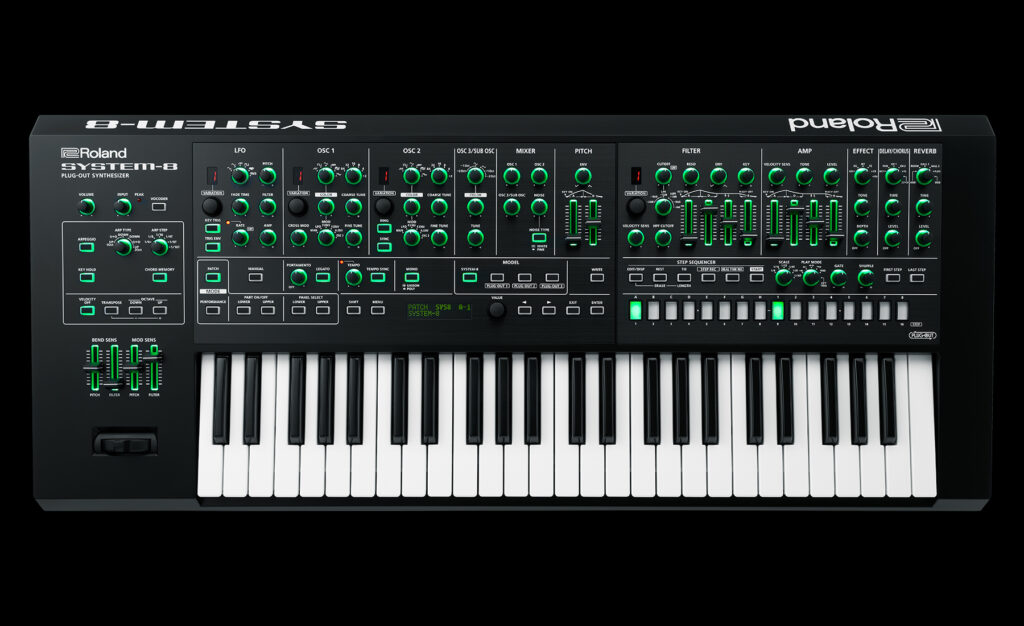Roland System 8 is a versatile performance synthesizer. This instrument is of the same excellent caliber as others produced by Roland. It is a modern and beautiful synthesizer made by Roland. The SYSTEM-8 is the end product of more than 40 years of synthesizer research and development at Roland, which has produced some of the most recognizable instruments ever.
The bundled JUPITER-8, JUNO-106, and JX-3P synthesizers are some of the most sought-after classics, and it completely nails their sound and behavior yet it accomplishes so much more. It combines several specialized effects with various current and old oscillator and filter types to create brand-new sounds that have never been heard before. It creates fully developed musical ideas with the integrated polyphonic sequencer with motion recording and a vast variety of high-resolution controllers.
Also Read: Yamaha CLP-795GP Review
About Roland System 8
The Roland System 8 contains a 49-Key plug-out synthesizer with Jupiter-8 and junior-106 plug-outs, 8 voices, 3 oscillators, an analog circuit behavior engine, polyphonic step sequencing, an arpeggiator, and a vocoder.
The SYSTEM-8’s synth design is based on years of research and development by Roland, and it has accurate replicas of vintage oscillators, filters, and effects. Not to mention the vast selection of renowned synthesizers accessible on Roland Cloud, it also has built-in replicas of the JUPITER-8, JUNO-106, and JX-3P.
The SYSTEM-8, however, reaches far beyond the past. It has a variety of digital and analog oscillators in different flavors, including Saw, Square, Triangle, SuperSaw, FM, and other totally distinctive waveforms. The well-known JUPITER and JUNO filters as well as more modern models like the distinctive Side Band Filter are available as filter options.
Have you ever imagined what an FM synth with knobs and a JUPITER-8 filter might sound like? You can now find out. The Roland System is unmatched in its flexibility since it can divide, layer, and mix numerous synth engines. With a few adjustments to its high-resolution settings, it can go from glass to growl.
Three expansion slots on the SYSTEM-8 allow you to host and operate PLUG-OUT synthesizers, which are fully functional replicas of vintage Roland synths that you may switch in and out whenever you choose. It is possible to combine the native synth engine with any hosted PLUG-OUTs to build super-synth patches with layered voices and bespoke splits since JUPITER-8, JUNO-106, and JX-3P PLUG-OUTs are featured.

The JUNO-60, SH-2, SH-101, PROMARS, SYSTEM-100, and many more PLUG-OUT instruments are available on Roland Cloud as well as DAW plug-ins that may be controlled from the SYSTEM-8’s interface. The SYSTEM-8 offers one of the most comprehensive control layouts out there, with a ton of knobs, sliders, and buttons to let you customize your sound. Dimmable lights enable you to see what’s going on in dark studios and provide feedback as to which controls are engaged.
The architecture of the controls is straightforward and fluid with tone adjustment in mind. You’ll receive superbly sounding, ultra-smooth parameter modifications that assist you in locating the sweet spots.
The polyphonic sequencer on the SYSTEM-8 is made to move quickly and fluidly, keeping up with your musical ideas’ swift tempo. The SYSTEM-8’s top and bottom levels each contain a separate sequencer that may activate external or internal devices linked by USB, conventional MIDI, or CV/GATE. The sequencer may also use motion recording to capture per-step or real-time parameter changes whether you record in step or real-time modes.
With distinct knobs for scale, gate, and shuffle as well as full control over playback modes and direction, keep things interesting and new. The SYSTEM-8 seamlessly fits into your studio setup or live rig thanks to its wide support for audio and MIDI through USB. It serves as a high-resolution audio interface, simplifying and streamlining live performance and on-the-go production settings.
Instead of using rows of generic controls, you may modify your favorite plugin instruments using an interface designed for tuning synthesizers thanks to the responsive 49 full-size keys and the enormous variety of lit knobs and sliders. For automated and simple one-to-one control, several Roland Cloud synthesizers even include modes that replicate the SYSTEM-8’s architecture.
Roland’s clever decision to equip System 8 with green LEDs was the first aspect of this synth that is attentive. Even with all the humor, the color selection is remarkable and was definitely intriguing at first glance. Green LEDs are included on the Roland System 1 much like their smaller sibling. The Korg Minilogue, for instance, doesn’t have as much color vibrancy. While the MicroKorg has some LEDs, they are not like as dazzling as what Roland is selling, it has a more industrial and minimalist appearance.

The keys themselves seem cheap, but everything else is top-grade. The Roland System 8’s 49 keys are nice. There are just 25 keys on the Roland System 1, compared to 37 on the MicroKorg and Korg Minilogue. The lack of full-size keys on the MicroKorg, though, is somewhat of a deal killer. In terms of appearance and general feel, the Roland (both System 8 and System 1) are higher-quality instruments, thus there is no competition.
The Roland System 1 is essentially a more portable version of the System 8 when compared to the other instruments we are looking at today. The Roland System 1 features, on the other hand, are effectively a halved version of the ones described for System 8 Roland, so keep that in mind as well. The System 1 Roland employs the AIRA ACB sound engine, has just 4 voices of polyphony at most, and has around half the amount of keys.
It has ten effects, eight presets, and no velocity capabilities. In comparison, the MicroKorg and the Minilogue have more keys, settings, and polyphonic capabilities.
- Four oscillators for buckets of fat synth tones
- Oscillator colors create continuous waveform changes from simple to complex
- All parameters can be controlled with physical knobs and sliders with LED indicators
In this regard, if you were to rank each instrument according to how well they compare in terms of features, the Roland System-8 would come out on top, followed by the Korg Minilogue, the MicroKorg would be third, and the Roland System-1 would be last.
Just because they like Roland items over Korg ones, some people might give the Roland System 1 a boost. The Roland System 8, however, is the undisputed champion in this regard. The Roland System 8’s filtering skills, in my opinion, are what distinguishes it the most from other synthesizers. Variation 1, which comprises LPF (-24 dB), LPF (-18 dB), LPF (-12 dB), HPF (-12 dB), HPF (-18 dB), and HPF, is an option (-24 dB).
When used by a skilled player, each of them gives the sounds themselves a distinctive quality. There are six distinct kinds available for filter variant 2. Cutoff, resonance, velocity sensing, envelop depth, key follows, and HPF cutoff is all controlled via knobs. The attack time, decay time, sustain level, and release time may all be adjusted by you. Despite having a respectable number of filter possibilities, the other instruments are nothing compared to what the Roland System-8 has to offer.
Two-quarter-inch audio inputs, two-quarter-inch outputs, and one-quarter-inch for headphones are all compatible with the Roland System-8. The Roland System 1 has the same number of outputs as the System-8 but no inputs. The Korg Minilogue features an eighth-in sync and a quarter-inch audio in. Additionally, it includes two quarter-inch outs, one for headphones and the other for audio, as well as an eighth-inch out for sync.
In addition to one TRS output for headphones, the MicroKorg offers two TS inputs and two TS outputs. Overall, the System-8 features a few more audio ins and outs connectivity possibilities. The MicroKorg is the only instrument out of the four that has MIDI in, out, and through. The MicroKorg receives a tiny advantage over the other three due to MIDI in/out.
Additionally, it is the only one that supports battery power. The fact that the MicroKorg lacks power sources or an AC converter is not a significant concern, but it does make the MicroKorg more portable. A type-B USB port, which is always useful to have, is the one feature that MicroKorg lacks in comparison to the other three. The Roland System-8 includes an SD card port, something none of the other instruments have.
Overall, another synthesizer with more connection choices is certainly available, but when it comes to these four, the System-8 is just somewhat superior to the competition. Although the Roland System-8 is a superior instrument, the price difference of two-thirds is not really justified. The System-8 is a little bit pricey.
Although there may be greater deals to be had elsewhere, possibly on the used or previously used market, the System-8 is not that much more valuable than these other instruments. One observes how stylish the Roland System-8 was, and that the quality of the Roland product was exactly what you would anticipate.
Sound is mostly a matter of personal choice. The sounds of the other instruments are excellent; they are just different. The drawback or perhaps just the “reality” is that you’ll have to spend more money on this specific synthesizer. Additionally, all of the instruments were competitive in terms of connection, however, the Roland System 8 ultimately won.

Alternatives of Roland System 8
- Roland JUNO DS61 features 8-Track Pattern Sequencer with non-Stop recording.
- Roland JUNO DS88 also has 128 Note Polyphony.
- Korg Minilogue features 16-Step Polyphonic Step & Motion Sequencer.
- Roland JD-XI has a Gooseneck mic with a built-in Vocoder & AutoPitch.
- Yamaha MX881 has 106 voices, 61 drum kits

Features of Roland System 8
- Versatile performance synthesizer with 49 full-size keys and cutting-edge ACB technology.
- The internal sound engine produces dynamic current sounds and vintage analog tones with an analog Vibe.
- Hosts three plug-out synths at once; Plug-outs for Jupiter-8 and Junior-106 are present.
- High-resolution controls for advanced low-pass, high-pass, and side-band filters.
- Enormous real-time control with specific buttons, sliders, and knobs.
- Polyphonic step sequencer featuring a traditional TRS-rec interface.
- Functions for polyphonic chord memory, vocoder, and arpeggiator.
- It has Cv/Gate outputs for connecting to modular synthesizers and retro equipment
- A wide range of onboard effects with controllable parameters
- Control surface with USB Audio/MIDI interface mode.
Sounds
The Roland System-8’s sound really amazed me. Here, you have access to a wide variety of high-quality sound selections. In fact, the sound engine is better than the ones in the MicroKorg and Korg Minilogue. There isn’t much of a difference between the sound engines of System-1 and System-8. So, if you appreciate the sound of the System-8, you probably will as well, and vice versa.
Specifications of Roland System 8
- It has 49 keys with velocity.
- It holds a maximum of Polyphony-8 voices.
- The Roland system 8 has 8 memories x 8 banks.
- There are 3 Oscillators
- Only one ENVELOPE Depth.
Also Read: Best Digital Pianos for Advanced Pianists
Pros of Roland System 8
- The system 8 Roland has a versatile performance synthesizer with 49 full-size keys and cutting-edge ACB technology.
- The internal sound engine produces dynamic current sounds and vintage analog tones with an analog Vibe.
- Hosts three plug-out synths at once; Plug-outs for Jupiter-8 and Junior-106 are present.
- High-resolution controls for advanced low-pass, high-pass, and side-band filters
- Enormous real-time control with specific buttons, sliders, and knobs
- Polyphonic step sequencer featuring a traditional TRS-rec interface
- Functions for polyphonic chord memory, vocoder, and arpeggiator
- A wide range of onboard effects with controllable parameters
- Control surface with USB Audio/MIDI interface mode
Cons of Roland System 8
- It just offers a few modulation possibilities.
- Cyclic filter sweeps and vibrato cannot be applied to the same sound on the Roland System 8.
- To route various components of your MIDI recording to various devices, you must perform further setup.
Competition
Many companies are competing with one another to outperform one another in order to keep their market leadership. The contest’s keyboards are;
Roland FANTOM-06 Synthesizer vs Roland System 8
Synthesizer keyboard, FANTOM-06 Streamline your artistic concept. The top-of-the-line FANTOM series’ powerful sound and smooth workflow are combined in the FANTOM-06 to create a portable instrument that brings your creative world together. Roland’s top sounds are available for you to play and produce with, and a color touchscreen, tactile controls, and sophisticated computer integration drawn from the flagship models will help you realize your musical vision.
The FANTOM-0 streamlines instruments that go wherever your imagination leads you, combining the sonic strength and smooth workflow of the top-tier FANTOM series. It unifies your creative environment. The FANTOM-06 contains everything you need to create and play at the greatest level, including a freshly created 61-note keyboard.
Roland’s cutting-edge ZEN-Core and SuperNATURAL technologies power hundreds of electronic and acoustic sounds for playback and production. With their new SuperNATURAL pianos’ true-to-life acoustic grand sound and response, virtual Tone Wheel Organ’s quick-fire playability and harmonic bar control, extensive onboard sampling features, and 4×32 USB audio interface, along with their native integration with Logic Pro, Main Stage, and Ableton Live, these products are among the best available today.
- FANTOM-0 brings your creative world together, combining the sonic power and fluid workflow of the top-of-the-line FANTOM series in streamlined instruments that go everywhere your inspiration takes you.
- Equipped with a newly designed 61-note keyboard, FANTOM-06 has everything you need to create and perform at the highest level.
- Play and produce with thousands of electronic and acoustic sounds powered by Roland’s advanced ZEN-Core and SuperNATURAL technologies
Roland Programmable Polyphonic Keyboard Synthesizer vs Roland System 8
Roland’s illustrious synthesizer line is elevated into a new era with JUNO-X, which combines a genuine vintage character with contemporary creative capability. Use the upcoming JUNO-X engine, vintage JUNO-60, and JUNO-106 Models, XV-5080 and RD piano sounds, Model Expansions, and more to create and perform music. And combine them all with a comfortable, hands-on interface that makes you feel at home.
JUNO-X is able to travel anywhere your music exists in the past, present, or future thanks to the broad capabilities of our ZEN-Core Synthesis System. With the help of the ZEN-Core Synthesis System, the renowned JUNO synthesizer experience has been recreated.
Newly created JUNO-X Model with Super Saw oscillator, velocity sensitivity, Chorus III effect, and more; authentic Models of the JUNO-60 and JUNO-106 synths from the 1980s; versatile sounds from the XV-5080, RD-series pianos, and Roland’s classic vocoder; user slot for loading Model Expansions such as the JUPITER-8, JD-800, Vocal Designer, and others from Roland Cloud; quick and easy.
- The legendary JUNO synthesizer experience reimagined with the power of the ZEN-Core Synthesis System
- Newly developed JUNO-X Model with Super Saw oscillator, velocity sensitivity, Chorus III effect, and more
- Authentic Models of the JUNO-60 and JUNO-106 synths from the 1980s
Roland 49-Keys Synthesizer vs Roland System 8
The JD-XA is a special hybrid synth that combines analog warmth and digital adaptability in a totally original, no-compromise instrument. A four-part, all-analog monster with actual analog filters and a direct dry output is the first thing you’ll notice. The next feature is a four-part digital engine with an astounding array of strong effects using Roland’s Supernatural synth technology.
The JD-engines XA’s offer an exceptionally flexible platform for sound design, studio work, and live performance because they may be utilized separately or together. Use the analog and digital components together, stack them for ultimate aural destruction, or modify digital waveforms with analog filters to produce previously unheard sounds. You may forget about analog or digital with the JD-XA.just close your eyes, imagine how the future sounds, and start creating music.
- Advanced synthesizer with independent analog and digital sound engines
- Discrete analog synth engine (four parts) with 2 x OSC, Filter, Amp, 4 x Env (2 x Pitch, Filter, Amp), and 2 x LFO per voice plus Analog Dry Out for raw signal output
- Analog filter section features 4-Pole, transistor-ladder, and multi-mode (LPF/HPF/BPF) filters with supremely smooth, natural response to knob movements
Roland Compact Digital contemporary F-140R-CBvs Roland System 8
Modern, sleek, 88-key console piano featuring a PHA-4 weighted hammer-action keyboard with escapement, rhythmic accompaniments, Twin Piano mode, Bluetooth MIDI/USB interface, integrated stereo speakers, and 3D Headphone Ambience with two headphones ports. The F-140R is a digital piano designed for modern life, offering top piano performance. It has a modern, tiny design that’s ideal for studio flats, and it’s brimming with technology from the pioneer in digital piano innovation.
First off, the piano tone you hear is incredibly real and expressive for such a little, reasonably-priced instrument. During private practice, the 3D Ambience effect of the headphones thoroughly immerses you in your performance while the built-in stereo speakers produce a rich, full sound. Playing is made more enjoyable by onboard rhythm accompaniments, which give you control over a backing band that automatically follows the chords you play.
With inbuilt recording, Bluetooth connectivity for utilizing smartphone/tablet applications, and a USB connector for connecting to a computer, the F-140R may help you better both your playing and composition.
- Roland’s industry-leading piano technologies in a stylish, affordable instrument for smaller living spaces
- SuperNATURAL Piano delivers the rich, authentic tone of a real acoustic grand
- Connect your smartphone or tablet via Bluetooth technology for wireless remote control, learning games, and digital sheet music with Roland's Piano Partner 2 app.
Conclusion
The Roland System 8 having been reviewed is a fantastic synthesizer. However, the cost can make you less eager to buy it. Go for it if you believe a less expensive synth, like the Korg Minilogue, may satisfy the majority of your demands. Just for its excellent native engine, the Roland System-8 is certainly worth the admission cost. When you take into account the Juno, Jupiter, the audio interface/CV capabilities, the sequencer, and a competent vocoder, it’s tough not to be impressed (plus audio inputs with dedicated FX). However, there’s a strong probability that you’ll be pleased with the Roland System 8 if you believe it is best suited to perform particular duties you need to be done.
Also Read: Best Digital Pianos for Intermediate Players
You Might Also Like:
- Yamaha Clavinova CLP-775 Review
- Best Synths for Ambient Music
- Best Digital Pianos Under $700
- Best Digital Piano for Classical Pianists
Frequently Asked Questions (FAQs)
1. Is The Roland System 8 Worth It?
The Roland System-8 is easily worth the entry fee just for its superb native engine. It’s difficult not to be impressed when you consider the Juno, Jupiter, the audio interface/CV capabilities, the sequencer, and a respectable vocoder (plus audio inputs with dedicated FX). The Roland SYSTEM-8’s synth design is based on years of research and development by Roland, and it has accurate replicas of vintage oscillators, filters, and effects.
2. Is Roland System 8 Analog Or Digital?
This is analog. 49-key Roland System-8 plug-in synthesizer Features: Analog Circuit Behavior technology is used in this powerful 49-key performance synthesizer. With 8 voices, 3 oscillators, filters, modulation, and other features, you can produce complex tones. The internal sound engine produces both vintage and contemporary analog sounds. Additionally, it features several types of oscillators in both digital and analog styles, including Saw, Square, Triangle, SuperSaw, FM, and other totally original waveforms.
3. When Was The Roland System 8 Released?
In 2017, the Roland Cloud System-8 was introduced. The System-8 Roland isn’t a direct replication of any specific vintage synth from the last 30 or 40 years, in contrast to many of their other Cloud products.
4. What Plugouts Are Available For System 8?
It is possible to combine the native synth engine with any hosted PLUG-OUTs to build super-synth patches with layered voices and bespoke splits since JUPITER-8, JUNO-106, and JX-3P PLUG-OUTs are featured.
5. Can Roland System 8 Be Used As A Midi Controller?
Through MIDI, you may use your AIRA SYSTEM-8 to command other components of your synthesizer setup or DAW. Additionally, you may use MIDI to control any setting on the Roland SYSTEM-8 from an outside source making it easier. Configure the MIDI configuration that best meets your needs by using the numerous SYSTEM MENU options!







